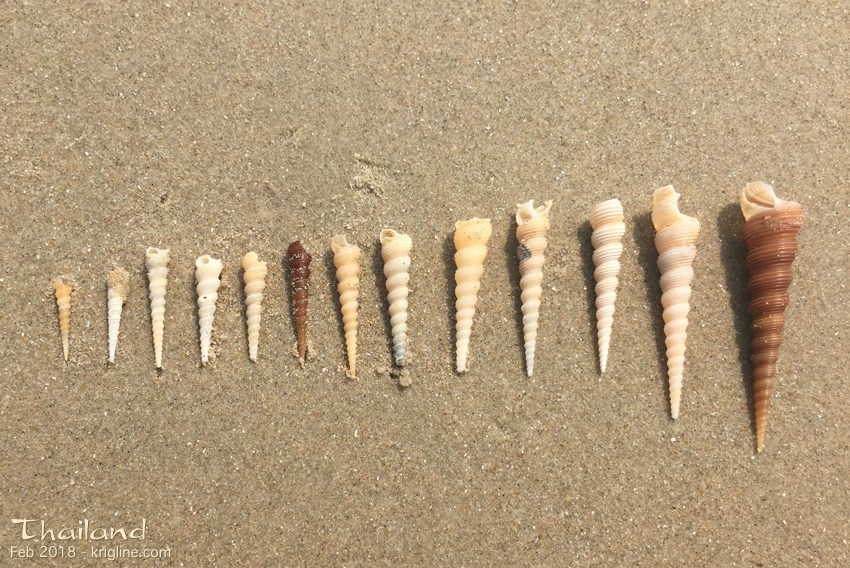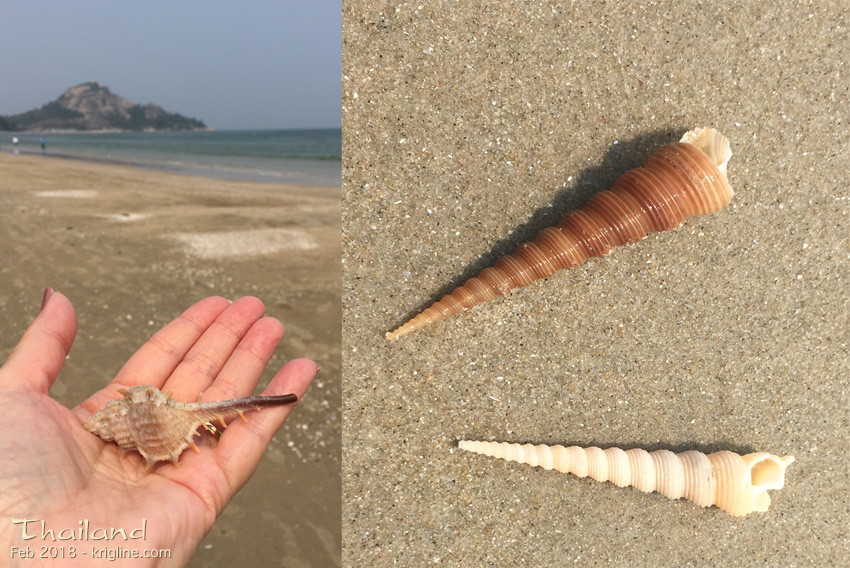↑Some Thoughts from the Beach
What do you see in the beauty of a shell? ⇔
by Michael Krigline, March 3, 2018. wp.krigline.com ⇔
 Any thinking person, seeing this line of shells on the beach, would immediately assume that it was created by a person. No monkey, fish, dog or bird is capable of this kind of order or design; I don’t even think we know of animals who are concerned with order, size, or the other “thinking skills” that even children can display on a beach. In truth, I found all of these shells within a three-foot circle, and the beauty and variety caught my interest.
Any thinking person, seeing this line of shells on the beach, would immediately assume that it was created by a person. No monkey, fish, dog or bird is capable of this kind of order or design; I don’t even think we know of animals who are concerned with order, size, or the other “thinking skills” that even children can display on a beach. In truth, I found all of these shells within a three-foot circle, and the beauty and variety caught my interest.

Aesthetic arrangements—something ordered to enhance beauty—are an even higher level skill. In a way, our ability to “create” things of beauty is a defining part of what makes us human. To those of us who are Christians, this ability is a faint glimpse of how our Creator created us in His image (Gen 1:26)—for the first thing the Bible teaches about God is that He creates; indeed, the Bible’s first five words are: “In the beginning, God created…” (Gen 1:1)

But take a look at the shells themselves. How and why does a tiny creature create such a thing, with a sharp point winding out to this opening? I guess the answer lies in its DNA—a complex information system that produces this reproducible creature with its special skills. And that DNA information-chain itself is a “wonder,” for it is more complex and ordered than basic computers.
It baffles me that many people who clearly see intelligence in the first two photos can’t see the same reflection of intelligence in the order and beauty of these shells, and the creature that wove them, not to mention it’s DNA and the complex ecosystem in which it lives—sand, sea, mountains, creatures of various kinds, etc. It defies logic that a childish arrangement of shells clearly signifies intelligence, while believing that the shells themselves (and everything else) are merely the product of time and chance. I even remember a famous scientist exclaiming that when studying nature you have to keep telling yourself “this was not designed” because it really looks like it was! Why fight the obvious conclusion? Standing on the beach in Thailand, I happily surrendered to that conclusion in the awe-inspiring things all around me. To me, design reveals itself on all sides, from the shells to the tiny crabs at my feet, and from the order of the heavens to the information organized into DNA.
A second after I took the second photo, a tiny wave washed over the shells and in a moment, they were disordered and partially buried in the sand. This is what time and chance do. Rust and mold, sunlight, waves and wind corrupt, they do not bring order and life. But perhaps not forever, “for the creation was subjected to futility…in hope that the creation itself will be set free from its bondage to corruption and obtain the freedom of the glory of the children of God.” (Rom 8:20,21 ESV)
In some ways I envy the child who has time to play with shells. Hurts, broken dreams, and a lifetime of not-getting-their-way have not taken away simple joys, childlike faith, and an appreciation for beauty as they find it. It takes an adult to explain-away the wonders of creation, not to mention the beauty of simple “rules” such as “do to others what you would have them do to you.” But nature and the God who created it keep lavishing upon us the beauty of a beach or forest, as well as an abundance of forgiving-grace and holy-love, to all who are willing to see through the eyes of childlike faith.
Discussion:
- What is your favorite kind of shell (pointed, fan-shape, round, big, small, what color…)? Why?
- What are some things that children can see, but adults miss? Why?
- What makes something “beautiful” to you? Do you think animals think of things as “beautiful” or “ugly”? Why or why not?
- Do you see “intelligence” in all three photos, or only the first two (or in none of them?)? Explain.
- Jesus said, “Blessed are the pure in heart, for they shall see God.” (Matt 5:8) What do you think he meant? How does one get a “pure” heart? How or where will these “pure-hearted” people see God?
Original content ©Michael Krigline, including photos if noted. For contact info, visit About Us. For privacy info or to make a contribution, see our Website Standards and Use Policy page (under “About Us”). [Titles that start with ↑ point to devotional articles that help us “look up”.]
